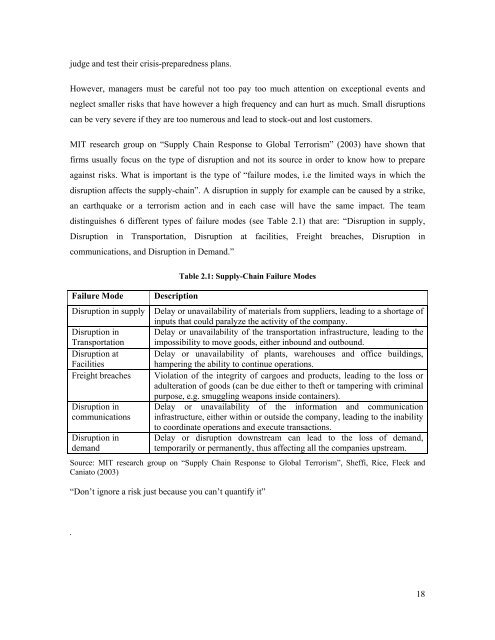Managing Risks of Supply-Chain Disruptions: Dual ... - CiteSeerX
Managing Risks of Supply-Chain Disruptions: Dual ... - CiteSeerX
Managing Risks of Supply-Chain Disruptions: Dual ... - CiteSeerX
You also want an ePaper? Increase the reach of your titles
YUMPU automatically turns print PDFs into web optimized ePapers that Google loves.
judge and test their crisis-preparedness plans.However, managers must be careful not too pay too much attention on exceptional events andneglect smaller risks that have however a high frequency and can hurt as much. Small disruptionscan be very severe if they are too numerous and lead to stock-out and lost customers.MIT research group on “<strong>Supply</strong> <strong>Chain</strong> Response to Global Terrorism” (2003) have shown thatfirms usually focus on the type <strong>of</strong> disruption and not its source in order to know how to prepareagainst risks. What is important is the type <strong>of</strong> “failure modes, i.e the limited ways in which thedisruption affects the supply-chain”. A disruption in supply for example can be caused by a strike,an earthquake or a terrorism action and in each case will have the same impact. The teamdistinguishes 6 different types <strong>of</strong> failure modes (see Table 2.1) that are: “Disruption in supply,Disruption in Transportation, Disruption at facilities, Freight breaches, Disruption incommunications, and Disruption in Demand.”Failure ModeDisruption in supplyDisruption inTransportationDisruption atFacilitiesFreight breachesDisruption incommunicationsDisruption indemandTable 2.1: <strong>Supply</strong>-<strong>Chain</strong> Failure ModesDescriptionDelay or unavailability <strong>of</strong> materials from suppliers, leading to a shortage <strong>of</strong>inputs that could paralyze the activity <strong>of</strong> the company.Delay or unavailability <strong>of</strong> the transportation infrastructure, leading to theimpossibility to move goods, either inbound and outbound.Delay or unavailability <strong>of</strong> plants, warehouses and <strong>of</strong>fice buildings,hampering the ability to continue operations.Violation <strong>of</strong> the integrity <strong>of</strong> cargoes and products, leading to the loss oradulteration <strong>of</strong> goods (can be due either to theft or tampering with criminalpurpose, e.g. smuggling weapons inside containers).Delay or unavailability <strong>of</strong> the information and communicationinfrastructure, either within or outside the company, leading to the inabilityto coordinate operations and execute transactions.Delay or disruption downstream can lead to the loss <strong>of</strong> demand,temporarily or permanently, thus affecting all the companies upstream.Source: MIT research group on “<strong>Supply</strong> <strong>Chain</strong> Response to Global Terrorism”, Sheffi, Rice, Fleck andCaniato (2003)“Don’t ignore a risk just because you can’t quantify it”.18
















